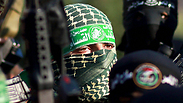
Demilitarization will have to wait
Analysis: Obama sees Gaza's demilitarization as a realistic and desirable goal, but not as an alternative to the result on the battlefield.
This issue is likely to become another bone of contention between the United States and Israel in the near future.
What is demilitarization and what are the conditions under which it can be achieved and enforced? The principal way of demilitarizing a state or a territory is bringing one of the fighting sides to a situation of unconditional surrender. That's what happened with Germany and Japan after their defeat in the world wars. These two world powers were forced to lay down their arms, and the armies of the winning countries were stationed on their territory and enforced their disarmament.
The second way is demilitarization by consent – whether as an interim step between two fighting sides or as a way to end the conflict. At the end of the War of Independence, demilitarized zones were set between Israel and some of the Arab countries. In the peace agreement between Israel and Egypt, the two states agreed to demilitarize Sinai, excluding Cairo's right to keep limited forces in the area.
The most outstanding recent case is Northern Ireland, where Britain and the terroristic faction of the Irish liberation organization reached a demilitarization agreement, while during the meetings Irish terrorists were still murdering British soldiers.
In discussions held in recent years between Israel and the Palestinian Authority, Israel has often raised demands to demilitarize the future state of heavy and advanced weapons. This is an agreement by consent rather than forced demilitarization after an unconditional Palestinian surrender.
There is no third alternative for reaching demilitarization. The Israeli discourse on this issue in recent says is likely taking place over the assumption that the "demilitarization of Gaza" is an alternative to two other goals – an agreement or arrangement between Israel and Hamas or destroying the organization.
The demand to demilitarize Gaza was not one of the original goals of Operation Protective Edge. Former Defense Minister Shaul Mofaz has informed the public that he was the one who raised the issue in his conversations with the prime minister and presented a detailed plan for its implementation.
But presenting such proposals right now is premature. Israel doesn't see a situation of coexistence with Hamas under any scenario, and so the demand for demilitarization as part of the conditions for the conclusion of Operation Protective Edge is like demanding that Hamas surrender at this early stage. Such a demand will become realistic after the battle is decided, not before.
Therefore, we should perhaps see Obama's approach towards the demilitarization demand as an adoption of Israel's vision in regards to the future of the Gaza Strip. He views Gaza's demilitarization as a realistic and desirable goal, but not as a practical alternative to the result on the battlefield. The achievement of victory is being left by the American president in Jerusalem's hands.
This approach matches the historical approach US presidents towards Israel. On the eve of the Six-Day War, Democratic President Lyndon Johnson didn't want Israel to launch a war against Egypt and preferred an international move which would lead to the opening of the Suez Canal. When he realized that Jerusalem had decided to go to war, the US stepped aside and cheered the winner six days later.
In the Yom Kippur War, the US helped with a massive airlift of armaments, but when Israel was about to bring down Egyptian President Anwar Sadat and the Russians threatened to get directly involved in the battle, the Republican White House threatened Jerusalem with isolation.
Sadat surprised Israel by agreeing to its demand to hold direct talks between military officers to settle the end of the fighting, and US President Richard Nixon and Secretary of State Henry Kissinger cheered Israel and eventually scored an achievement: A peace agreement between the two enemies on the White House lawn.
Three weeks after the onset of the Protective Edge battles, the US supports Israel right to self-defense but wants the battle to be decided, rather than an alternative in the form of "demilitarization."
Efraim Halevy is a former head of the Mossad.










